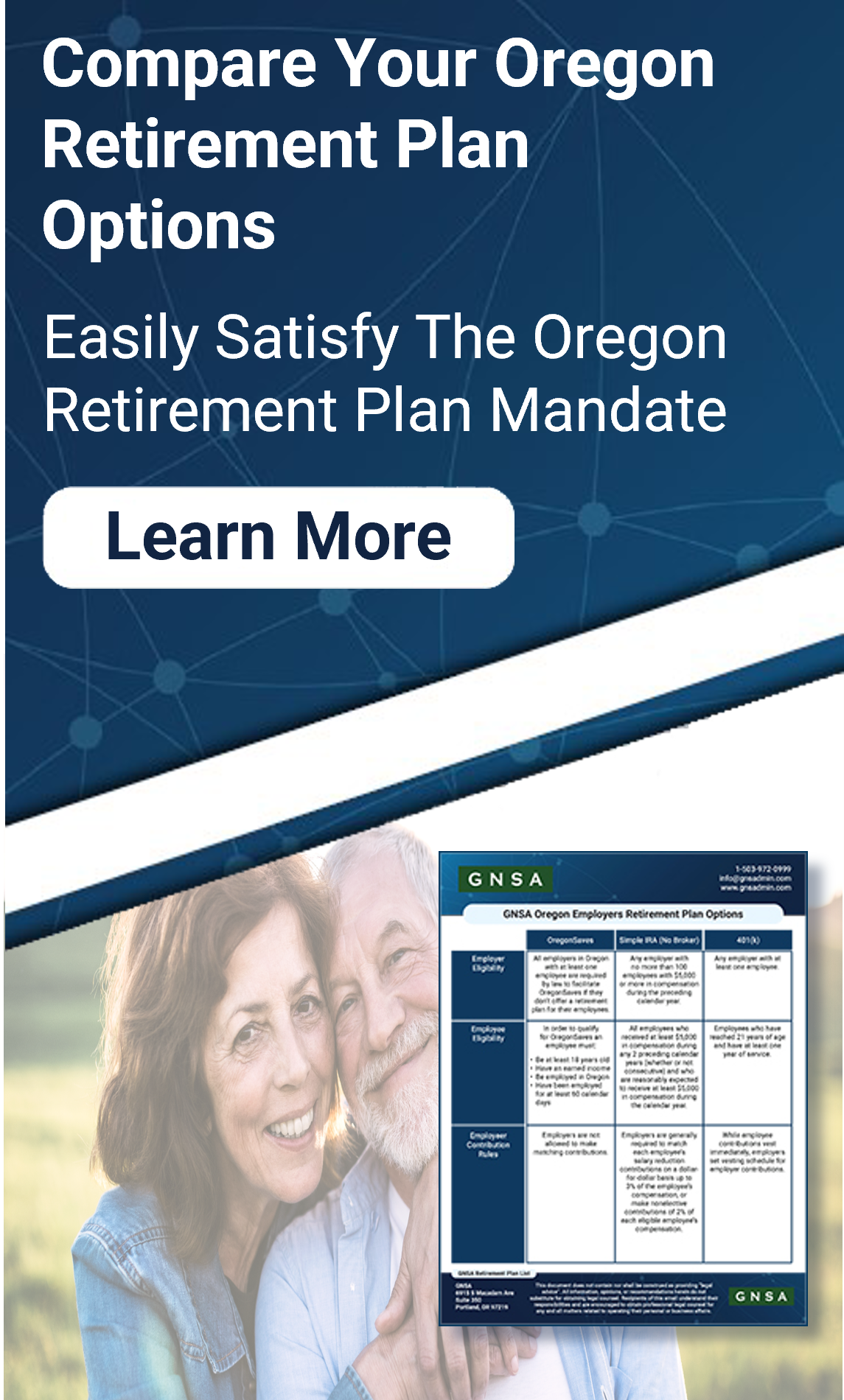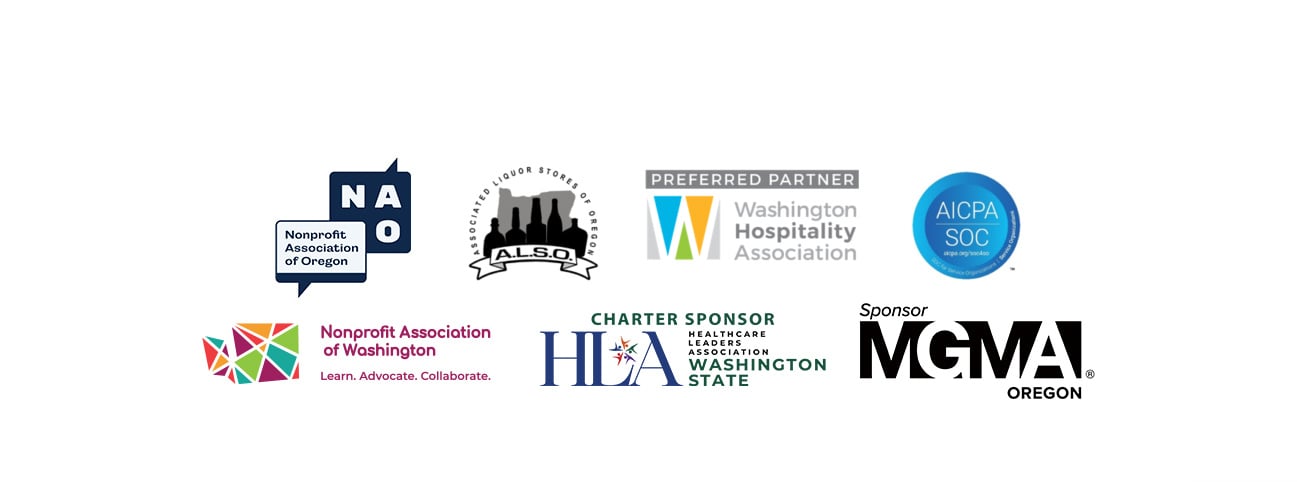According to the Boston College of Retirement Research, half of the people in the U.S. won't have enough funds saved to keep their standard of living during retirement. Additionally, over a third of workers have less than $1,000 in retirement savings.
While the 2008 financial crisis helped contribute to this shortfall, other factors such as wage stagnation, income inequality, and a gap in small business retirement plan options have also added to the dilemma. To help counter this retirement crisis, several states have created their own retirement programs tailored to private employees, with a special eye on assisting the self-employed and those within smaller organizations who aren't currently offered a company-sponsored retirement plan.
OregonSaves and Oregon Retirement Plan Mandate
Under the Oregon retirement plan mandate, also known as OregonSaves, all employers in Oregon are required by law to facilitate OregonSaves if they don't offer a retirement plan for their employees.
Employers looking for Oregon Retirement Plan Mandate Options to comply with these requirements should Contact an Oregon Retirement Plan Provider today.
What is OregonSaves?
OregonSaves is a state-run retirement program that offers a Roth IRA savings plan for Oregon residents and workers employed at in-state businesses. It's available to all self-employed individuals or private-sector employees who don't have company-sponsored retirement plans at their workplace.
The unique plan is meant to help small businesses and workers alike. It combines automatic enrollment with a payroll deduction IRA - or Auto IRA for short.
In other words, employees don't need to do anything if they want. After 30 days of being employed employees are auto-enrolled in the standard savings program and investment options. The default savings rate is 5 percent of total pay before taxes.
OregonSaves Requirements for Employees
In order for an employee to qualify for OregonSaves, he or she must:
- Be at least 18 years old
- Have an earned income
- Be employed in Oregon
- Have been employed for at least 60 calendar days
How to Opt-Out of OregonSaves if You Are an Employee
OregonSaves is a voluntary program, and employees can opt-out of OregonSaves at any time. Employees can also create an account and customize their savings choices, as well as add beneficiaries.
When did OregonSaves start?
The OregonSaves pilot program first launched on July 1, 2017, with notifications sent to companies with 100 or more employees. They were asked to either:
- Certify that they offer employees a qualified retirement plan or
- Register with OregonSaves by November 1st
The first-of-its-kind automated, state-administered IRA retirement plan for private individuals officially began on October 15, 2017, requiring companies with 50 or more employees to comply.
As of May 2021, the program has registered nearly 17,000 participants at an average monthly contribution rate of 5.6%. Many other states including California, Illinois, Massachusetts, and Washington have also developed retirement plan mandates. See a list of states with retirement mandates on this page.
Is OregonSaves Mandatory?
In short, no OregonSaves is NOT mandatory. Rather, OregonSaves is a simple option to satisfy Oregon's Retirement Plan Mandate, which requires that eligible employers offer a qualified retirement plan to employees.
OregonSaves 2023 Update
Back in March of 2023, businesses with at least three employees became required to offer a qualified retirement plan if they were not going to or didn't want to sign up for OregonSaves.
As of July 31st, 2023, the final OregonSaves update was put into place, requiring all businesses with at least one employee as well as those utilizing a Professional Employer Organization (PEO) or Leasing Agency to offer a qualified retirement plan or OregonSaves.
OregonSaves 2025 Requirements for Employers
Under Oregon's retirement plan mandate, all employers with at least one employee must facilitate OregonSaves if they don't offer any other Oregon retirement plans. Qualifying plans include a 401(k), Simplified Employee Pension plan, SIMPLE IRA, governmental deferred compensation plan, qualified annuity, or tax-sheltered annuity plan.
How to Register for OregonSaves
Oregon employers who are looking to register for OregonSaves will need the following items to do so:
- Your Federal Employer Identification Number (EIN)
- The OregonSaves Access Code from your notification
The OregonSaves program reaches out to businesses to notify them of their upcoming registration date, and the verification code received in that notification is the access code, mentioned above.
OregonSaves Registration Deadlines
All registration deadlines for OregonSaves have past. If you do not offer a retirement plan for your employee, sign up for OregonSaves now.
Administering and Managing OregonSaves
Employers are required to upload payroll and employee information, as well as submit employees' savings contributions, each period, as well as keep their staff list up to date if they decide to use OregonSaves. Employers can use this OregonSaves Registration Checklist for help.
Because of this, many employers are having trouble with OregonSaves as it requires manual 401(k) administration. As a result, many Oregon businesses are turning to integrated 401(k) solutions that have a 360 integration with payroll, eliminating the need for things like manual data entry and reducing the administrative burden.
What Payroll Information Must be Submitted to OregonSaves?
At the close of every pay period, employee contribution data needs to be provided to OregonSaves. Your Oregon payroll company should have the ability to set up a retirement plan feed or API integration that allows this data to be sent to OregonSaves automatically once payroll is finalized.
OregonSaves Common Questions
Here are some common questions and other important things to know about OregonSaves.
Are There Other Requirements Outside of Offering a Retirement Plan?
Here are just a few more key requirements to make note of about OregonSaves:
- Employers are not allowed to make matching contributions.
- Out-of-state employees are also eligible for the program if their employment is based in the state.
- Seasonal employees and H2-A Visa holders are eligible for the program if they work more than 60 days.
- Work-study students and those not holding a Social Security or individual tax id number are not eligible for the program.
- Employees can participate in both your company retirement plan and OregonSaves if they choose to self-enroll.
- Payroll deduction IRAs do not count as employer-sponsored retirement plans.
- If you offer a retirement plan to certain individuals at your company, such as those who meet your age criteria, you can certify for an exemption.
- Once employees are enrolled, they have 30 days to opt-out or adjust their savings rates and investment options.
- Facilitation of the program includes: registering, account setup, enrolling employees, educating employees on the program, making payroll deductions, and managing contributions
- Payroll representatives can be added to assist with managing contribution amounts, automatic deductions, and program compliance.
How Is OregonSaves Funded?
The program is free to employers and funded entirely by employee contributions, at a rate of about 1% ($1 per $100 contribution) annually. This covers investment fund fees, program administration by expert IRA specialists, customer and data service staff, and Oregon Retirement Savings Board costs. OregonSaves currently holds about $113 million in assets.
What Special Paperwork Is Needed for OregonSaves?
Tax Form 5498 must be filed annually with the IRS by employers to report employees' IRA retirement contributions. A copy must also be furnished to all staff members by May 31st each year. However, no information needs to be reported on employees' W-2s, and they do not need to send Form 5498 or any other form to the IRS when they file taxes.
What Kind of IRA Plan Does OregonSaves Offer?
The Roth Auto IRA offered by OregonSaves differs from Traditional IRAs in that all contributions are after-tax withholdings. This means that you won't owe taxes on the funds when you retire, which can be a big stress-reliever for retirees on a budget. There are also no age limitations for contributions to a Roth, meaning you can keep saving after age 70.5 as long as you're still earning income.
Employees who use OregonSaves and meet income requirements of no more than $140,000 for a single tax filer and $208,000 if married and filing jointly are able to contribute up to $6,000 per year at any age, and $7,000 a year at age 50 or older.
While the direct funds you contribute can be withdrawn at any time without taxes or penalties, a Roth IRA encourages employees to keep saving by taxing and penalizing withdrawals on interest, unless:
- A five-year holding period has passed and
- You've reached age 59.5 or
- You've become disabled or
- You use the funds for first-time homebuyer costs (up to $10,000) or
- Your beneficiaries use the funds following your passing
OregonSaves Penalty for Non-Compliance
The following penalties may be incurred for violations of Oregon retirement plan mandates under OregonSaves.
Fines and Fees
While there was a two-year grace period on penalties for failing to comply with OregonSaves, in 2019 that all changed. SB164, which outlines the penalties for failing to comply with the program's regulations, was signed into law by Governor Kate Brown and officially went into effect on January 1, 2020.
Under its provisions, if you don't offer a retirement savings plan or don't properly facilitate the OregonSaves program, you could incur fines of $100 per employee, up to a maximum of $5,000 annually.
Legal Penalties
What's more, expensive employer-sponsored retirement litigation has soared in recent years. According to a Boston College report, a key focus of these lawsuits is regulatory and financial compliance. One example is Brown University's recent settlement of a huge class-action lawsuit for $3.5 million over its failure to properly automate recordkeeping. Anthem will also pay out $24 million beginning in 2019 for similar Employee Retirement Income Security Act (ERISA) violations.
Oregon Retirement Plan Mandate - Satisfy Your Requirements
Employers looking for help with OregonSaves or getting started with Oregon Retirement Plans should contact an Oregon Retirement Plan Provider today.
With GNSA you can count on our experienced team of in-state Benefits Administration experts to quickly and accurately upload your employee deductions - on time, every time.
We keep you in compliance with Payment Conveyance Services (PCS), and will even guide you through the best Oregon retirement plan options to help attract and keep amazing talent in your organization now and for years to come. Contact our Portland payroll support office today to learn more.


.png)


